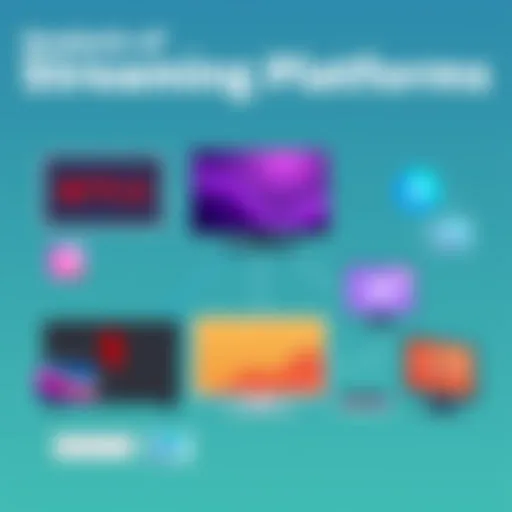Exploring Free Windows Images: A Complete Guide


Intro
In the rapidly evolving landscape of technology, the demand for cost-effective solutions is paramount, particularly with operating systems like Windows. Free Windows images have become an integral component for both individuals and organizations seeking to optimize their digital environments without incurring significant expenses. This article aims to delve into the various aspects surrounding free Windows images, providing a rich reservoir of information that caters to the needs of tech-savvy individuals.
Understanding the intricacies involved in sourcing and deploying free Windows images is essential for achieving efficiency and reliability. As we explore different types available, we will discuss their benefits and limitations, thereby giving the reader a comprehensive outlook. Additionally, this article will guide proper practices for downloading and using these images, ensuring that readers can navigate the process smoothly and effectively.
The subsequent sections will detail various features, specifications, and considerations that must be addressed to utilize free Windows images to their fullest potential, whether for personal use or professional endeavors.
Understanding Windows Images
In the realm of computing, understanding Windows images is crucial for optimizing system functionality, enhancing user experiences, and managing software development processes. Windows images encapsulate various aspects of the operating system that are essential for installation, recovery, or system restoration. By grasping the fundamentals of Windows images, users can effectively navigate the complex landscape of operating systems while ensuring their systems function optimally.
Defining Windows Images
Windows images are files that serve as templates for deploying the operating system across multiple devices. Essentially, they provide a snapshot of a complete system configuration, including files, settings, and applications necessary for operating system deployment or recovery. The primary function of these images is to streamline the installation process, allowing users to replicate a standard system setup quickly and efficiently.
Types of Windows Images
System Images
System images are comprehensive backups of the entire operating system environment. They encapsulate the operating system itself, alongside all installed applications and data files. This type of image plays a vital role in system recovery. When a critical failure occurs, users can restore their systems to a previous state without the need for lengthy reinstallation procedures. The key characteristic of system images is their holistic nature, offering a full package that includes not just the OS, but all user-defined settings. This makes system images a popular choice among IT professionals who aim to minimize downtime.
Installation Images
Installation images, on the other hand, focus primarily on delivering the operating systems and not on user data or programs. These images often come in the form of an ISO file that can be used to create bootable media, enabling users to install the operating system on new machines or as part of fresh installations. The primary benefit of installation images lies in their simplicity and focus. They are user-friendly, making them a common go-to for individuals who need to set up Windows on multiple systems. However, they lack the personalization of system images, which can lead to repetitive configuration tasks.
Recovery Images
Recovery images are designed specifically to restore a device to its factory settings, a safe state, or a configured setup without using OS installation media. They often come pre-installed on computers and can include essential tools for troubleshooting issues. The advantage of recovery images is that they can quickly restore a system after corruption or failure. However, their limitation lies in their typically restrictive functionality, which might not cover more profound issues that require a full reinstallation of the OS from scratch.
The Significance of Free Windows Images
The role that free Windows images play in the technology landscape is substantial. They provide accessible solutions for users who seek to install, restore, or optimize Windows systems without incurring high costs. These images are essential for many individuals and organizations because they remove barriers to entry, enabling a wider adoption of Windows operating systems.
While free Windows images can offer numerous advantages, several considerations warrant careful scrutiny. Factors such as support, updates, and security mean that users must be well-informed about their choice of Windows images.
Accessibility for Users
Accessibility is a core element of the significance behind free Windows images. People's varied economic situations often dictate their ability to obtain software. Free images are especially vital for students, freelancers, and smaller organizations that cannot allocate large budgets for software purchases.
Using free Windows images allows these users to benefit from a robust operating system, leveling the playing field. Education institutions often rely on these images to provide learning environments without the need for expensive licenses. Whether for a computer lab or a personal project, accessibility fundamentally enhances user engagement and experience.
Cost-Effective Solutions
Cost-effectiveness is another crucial aspect that underpins the importance of free Windows images. Businesses and tech enthusiasts regularly face tight budgets. Free images help reduce overall IT costs.
- Lower Licensing Fees: Individuals and small businesses can save significantly on licensing fees by using free images.
- Reduced Hardware Expenses: Users can install Windows images on older machines, extending their lifecycle and delaying hardware upgrades.
- Budget Allocation: Funds saved from software licenses can be redirected to other essential areas, like hardware or training.
In an era where businesses are increasingly scrutinizing spending, having access to free Windows images can play a pivotal role in financial planning and operational efficiency.
Impact on Learning and Development
The impact of free Windows images on learning and development is profound. These images create opportunities for hands-on experience with various configurations and software settings that might not be feasible otherwise. This risk-free environment encourages experimentation and creativity, essential traits in technology fields.
- Enhanced Skill Development: Learners can acquire and practice new skills without the constraint of costs.
- Encouragement of Innovation: Access to resources enables users to explore new ideas freely without a significant financial investment.
- Widespread Availability: The ease of access to these images promotes a culture of continuous learning and adaptation in fast-evolving technological landscapes.


Free Windows images not only serve as economical alternatives but also encourage exploration among learners and professionals, driving innovation and skills development.
Sourcing Free Windows Images
Sourcing free Windows images is a vital aspect of this article as it directly impacts the accessibility and utility of these resources for users and organizations. A well-informed decision-making process is crucial when acquiring these images, ensuring aspects such as legality, security, and support are considered. Free Windows images can significantly reduce costs while providing essential functionality. However, not all sources are created equal; hence, understanding where to find trustworthy images is essential in maximizing their benefits.
Official Microsoft Sources
Microsoft offers several official channels for obtaining free Windows images. These sources include the Microsoft Evaluation Center and TechNet. Users can access trial versions of various Windows operating systems, which are usually time-limited but provide legitimate testing environments. Microsoft ensures that these images are free from malware and come with essential updates, making them a reliable choice.
Using official sources allows users to experience the latest features and functionalities without the financial burden. Furthermore, it enables organizations to test software compatibility before large-scale deployment.
Third-party Websites
When exploring third-party websites for free Windows images, caution is necessary. While many sites offer accessible images, not all maintain the same level of security or legitimacy.
Reputable Sources
Reputable sources are critical when obtaining Windows images from third-party websites. Websites like Softpedia and MajorGeeks are widely recognized for hosting safe and legitimate software. The key characteristic of these sites is their dedication to user safety. They often scan all downloads for viruses and malware, ensuring a lower risk during the acquisition process.
Using reputable sources has distinct advantages. They often provide additional resources such as user reviews and troubleshooting tips for the images offered. These insights can aid in making informed decisions and create less frustration during installations.
However, users should remain cautious. Even trusted sites can occasionally host outdated or corrupted files, so verification is always a good idea.
Risks Involved
While third-party websites can provide valuable resources, they also come with inherent risks. The most significant concern is security vulnerabilities. Downloading images from less-known sites may expose users to malware, which can compromise the integrity of their systems.
Users must understand the risks involved in relying solely on third-party sources. A unique feature of these risks is that they can result in data loss or system instability. Organizations particularly need to consider these factors when attempting to maintain secure environments.
In summary, while third-party websites provide additional access to free Windows images, it is crucial to approach these sources with a discerning eye. Always prioritize security practices, validate the sources, and proceed with caution.
Downloading Free Windows Images
Downloading free Windows images is an essential topic for users and organizations looking to optimize their technology solutions. Understanding the download process enables informed decision-making, ensuring that users acquire the correct version for their specific needs. Furthermore, familiarity with this process can lead to better resource management and cost savings.
In this section, we will break down the key elements of downloading Windows images, focusing on the procedure and the potential challenges that might arise. Being aware of the various facets of downloading free Windows images enhances the overall experience and minimizes disruptions during setup and deployment.
Step-by-Step Download Process
The step-by-step download process for free Windows images can often be straightforward, but it requires attention to detail:
- Identify the Version Needed: Determine which version of Windows you need. This may include looking at whether you want a Home, Pro, or Enterprise version.
- Select a Trusted Source: Choose an appropriate website for downloading. The Microsoft website is the most reliable option.
- Locate the Download Link: Once on the site, find the section that offers free Windows images, usually under Downloads or Resources.
- Download the Image: Click on the download link. Confirm any terms of service or conditions required.
- Verify File Integrity: After downloading, check the hash of the file against the official hash provided. This ensures the file’s integrity and that it hasn’t been tampered with.
- Extract Files if Necessary: Some images may be compressed. Use software like WinRAR or 7-Zip to extract the files if needed.
- Prepare for Installation: Follow the necessary steps to create a bootable USB or arrange for installation in a virtual environment.
This step-by-step guide ensures a smooth experience when acquiring a Windows image. Each step is vital in minimizing errors and ensuring a successful download.
Common Challenges and Solutions
While downloading free Windows images can be straightforward, various challenges may arise. Understanding these problems and their solutions can ease the path to successful installation:
- Slow Download Speeds: Users might experience reduced download speeds. To alleviate this, try downloading during off-peak hours or connect to a wired network for stability.
- Corrupted Files: Sometimes, files may become corrupted during the download process. In such cases, retrace your steps, redownload the file, and validate the hash to ensure integrity.
- Compatibility Issues: Some images may not work with certain hardware configurations. Before proceeding, always check the hardware requirements listed on the download site.
- Lack of Documentation: Free images may lack sufficient documentation. Seek resources and community help on platforms like Reddit or specific tech forums for guidance.
Deploying Free Windows Images
Deploying free Windows images is crucial for both individual users and organizations. This section will overview the importance of understanding how to properly deploy these images to achieve desired outcomes. When deploying a free Windows image, one must pay attention to system requirements, installation processes, and ongoing management. Proper deployment ensures that the operating system operates effectively and efficiently, which contributes to productivity.


System Requirements
System requirements play a significant role when it comes to deploying Windows images. It is essential to understand both hardware specifications and software dependencies.
Hardware Specifications
Hardware specifications define the physical components needed to run a Windows image. These specifications are vital in ensuring that the system can support the image being deployed. A key characteristic of hardware specifications is processing power. Systems with a robust CPU tend to run Windows images more smoothly.
A beneficial aspect of high processing power is the ability to manage multiple tasks efficiently. For instance, a machine with multi-core processors can handle more operations simultaneously. However, higher hardware requirements can also be a limitation. Sometimes, older hardware may not support the latest Windows images, thus this aspect needs careful consideration.
Software Dependencies
Software dependencies refer to other software components or framework needs for the Windows image to function properly. Understanding these dependencies is crucial for a successful deployment. A common characteristic of software dependencies is their necessity for optimal performance. For example, certain Windows images may depend on .NET Framework or specific drivers.
One advantage of recognizing software dependencies is the prevention of runtime issues post-deployment. This makes achieving a stable operating environment easier. Conversely, additional dependencies can complicate the installation process. Thus, verifying software requirements beforehand is essential.
Installation Process
The installation process of free Windows images requires detailed attention. To begin, users should ensure that all hardware meets the requirements specified for the Windows image being deployed. This involves checking compatibility lists and verifying hardware capacity.
Next, users can proceed with the installation through various methods, such as using USB drives or network-based installations. Once the process starts, following clear on-screen instructions is crucial.
After installation, it's beneficial to configure the system according to needs. Regular updates and patches should be scheduled. This helps in maintaining the system’s security and functionality.
Proper deployment of Windows images requires attention to detail and an understanding of both hardware and software requirements.
By focusing on these factors, individuals and organizations can ensure a smooth deployment process, fostering an effective computing environment.
Advantages of Using Free Windows Images
The utilization of free Windows images presents various advantages that appeal to users and organizations alike. These benefits encompass cost savings, flexibility, and the ability to meet specific requirements. Understanding these advantages is crucial for making informed decisions regarding the deployment of Windows images in different environments.
Customization Options
One of the primary benefits of free Windows images is the flexibility they offer in terms of customization. Users can modify these images to suit their unique needs and preferences. This provides the opportunity to tailor the operating system to specific use cases, whether for personal preferences or organizational requirements.
Customization can include:
- Installing specific applications: Users can add software that fits their workflow or enhances productivity.
- Configuring settings: Adjusting system settings to optimize performance for particular tasks.
- Applying security measures: Implementing tools and practices for enhanced security configurations.
With free Windows images, it is possible to create a customized environment that meets users’ needs precisely. This flexibility can lead to improved efficiency and satisfaction.
Facilitating Test Environments
Another significant advantage of free Windows images is their role in facilitating test environments. For developers and IT professionals, testing software applications in an isolated system is vital before rolling out changes or product updates in a live environment. Free Windows images can be particularly useful for this purpose.
This practice offers various benefits such as:
- Cost-effectiveness: Utilizing free images reduces financial barriers for testing software or conducting experiments.
- Speed of setup: Windows images can be deployed quickly, allowing for rapid testing cycles without the overhead of traditional installations.
- Risk management: Testing in a separate environment minimizes the potential risks to production systems when experimenting with new software or configurations.
Overall, free Windows images support an agile development process by enabling rapid testing and iterations. This can be advantageous for companies seeking to innovate continuously without incurring significant costs.
"The flexibility and cost-saving potential of free Windows images make them an attractive choice in various contexts, especially for testing and customization."
Limitations and Risks of Free Windows Images


Using free Windows images offers many advantages, but it is crucial to recognize the limitations and risks associated with them. A comprehensive understanding of these drawbacks helps users make informed decisions. By acknowledging these elements, one can strategize accordingly and mitigate potential issues that may arise.
Lack of Official Support
When utilizing free Windows images, the absence of official support is a significant concern. Official support from Microsoft provides users with updates, security patches, and troubleshooting assistance. Without this backing, users may find themselves without essential resources for resolving problems. This lack can lead to prolonged downtime if a system experiences issues. In a professional environment, downtime can incur significant costs.
Additionally, relying on free versions may limit access to advanced features or updates provided to licensed users. Thus, it becomes essential for organizations to evaluate the risk of operating without official support. The decision to use free images must factor in the potential for operational challenges and technical difficulties.
Potential Security Vulnerabilities
Security is one of the primary concerns regarding free Windows images. Many free versions may not receive regular updates, making them susceptible to vulnerabilities. Cyber threats evolve quickly, and software not patched against known vulnerabilities can become prime targets for exploitation. Moreover, some freely available images may originate from unverified sources. This could lead to downloading images containing malware or other malicious software, further exposing the system to risks.
Users must practice diligence in ensuring the authenticity of their Windows images. Engaging in community forums or checking credible sources for feedback can assist in determining the security reputation of an image. Any lapse in security can have dire consequences, affecting both personal data and broader network integrity.
Licensing Concerns
Licensing issues pose another important limitation when using free Windows images. While many images are advertised as free, users must fully understand the terms governing their use. Some images may be subject to licensing agreements that limit how they can be utilized, potentially resulting in legal ramifications for businesses that fail to comply.
Understanding the licensing framework is essential before deploying these images in any capacity. Engaging legal counsel for a thorough interpretation can mitigate risks. If organizations deploy an image that violates licensing terms, the resulting penalties could be severe, ranging from fines to forced cessation of service. Therefore, due diligence in reviewing licenses ensures that organizations protect themselves from legal challenges.
It is wise to consider both the short-term benefits and the long-term consequences when utilizing free Windows images. With careful planning and engagement with reliable sources, users can navigate the challenges and improve their chances for a successful deployment.
Best Practices for Utilizing Free Windows Images
Using free Windows images can offer substantial benefits, but proper utilization is critical. Adhering to best practices can help ensure optimal performance, security, and efficiency. The aim should be to maximize the benefits while minimizing potential risks associated with these images.
Regular Updates and Patching
One of the most important practices involves staying updated. Regularly updating the installed Windows images is essential. Updates not only enhance functionality but also address known vulnerabilities. Users should prioritize the following actions:
- Schedule Updates: Establish a routine for checking for updates. Automated settings can help in ensuring updates are not missed.
- Patch Management: Regular patching is crucial. Installing patches helps to mitigate risks associated with security flaws in the operating system.
- Backup Before Updating: Always create a backup before implementing updates. This way, if an update causes issues, you can revert to the last stable state.
By following these steps, users can maintain a secure and efficient environment for their Windows images.
Validation of Sources
Validating sources is another paramount practice when utilizing free Windows images. Ensuring that the images come from trusted sources minimizes the risks of malware and other threats. Users should consider the following guidelines:
- Official Sources: Always prioritize downloading from official Microsoft websites or reputable third-party vendors. This adds a layer of security and authenticity.
- User Reviews and Ratings: Before downloading from third-party resources, check user reviews and ratings. Look for references in tech forums like Reddit or tech community platforms.
- Scan Downloads: After downloading any image, use antivirus tools to scan the file. This preventive measure ensures that the downloaded content is free of malicious code.
In summary, validating sources helps in preserving the integrity of the system and protecting sensitive data. Following these best practices can significantly enhance the experience of using free Windows images.
The Future of Free Windows Images
As technology continues to evolve, the landscape of free Windows images is also likely to change. This section delves into the future of free Windows images, highlighting key elements that will shape its trajectory. With advancements in technology and shifting user needs, understanding these trends is imperative for both individuals and organizations. The availability of free Windows images offers significant benefits but also entails considerations that users must keep in mind.
Emerging Trends
One crucial trend is the growing emphasis on virtualization. Virtual machines are becoming increasingly popular for testing and development purposes. Free Windows images are being adapted to facilitate these virtual environments, allowing users to run multiple operating systems on a single machine. This will lead to greater flexibility and improved resource management. As businesses explore DevOps practices, the demand for efficient system images will rise.
Another emerging trend is the integration of artificial intelligence and automation. These technologies could streamline the process of creating and managing Windows images. For instance, tools that automate the provisioning of these images will enhance operational efficiency. Users will likely find that automation reduces the time and cost associated with deploying new systems.
The focus on security cannot be overlooked. As cybersecurity threats become more sophisticated, the future of free Windows images will likely include enhanced security features. These may involve better detection of vulnerabilities and proactive measures to safeguard against them. Users must stay informed about these advancements to ensure they are using secure images in their environments.
Impact of Cloud Services
The rise of cloud services is another pivotal factor influencing the future of free Windows images. As more users shift to cloud computing solutions, the availability of cloud-based free Windows images is becoming commonplace. Users will find it advantageous to leverage cloud environments for testing and deployment. This not only enhances accessibility but also allows for greater scalability without significant investment in hardware.
Cloud services will provide a platform where images can be updated in real-time, ensuring users always have the latest versions. This will significantly reduce the risks associated with using outdated images. Moreover, collaboration between teams will be simplified, as multiple users can work on the same projects from different locations.
With these developments in mind, it is essential to recognize that while free Windows images enhance accessibility, they also require careful evaluation of security and licensing issues. Organizations must implement rigorous policies to ensure that they are compliant with regulations and that their data remains secure.
"The future of free Windows images is intertwined with technological evolution, providing opportunities and challenges that users must navigate with caution."



